
Kinkell is a former parish in the Garioch region of Aberdeenshire. It was named Kinkell (Gaelic for "head church") because its parsonage oversaw six subordinate churches. [1]

Kinkell is a former parish in the Garioch region of Aberdeenshire. It was named Kinkell (Gaelic for "head church") because its parsonage oversaw six subordinate churches. [1]
The area where Kinkell once stood is now part of the town of Inverurie, Aberdeenshire. The ruins of the Kinkell Kirk sit on the East bank of the River Don, two miles south-southeast of Inverurie [2]
Kinkell Kirk is a medieval church built in the 1200s [3] and redesigned in 1538. It is dedicated to St Michael. [4]
The 16th-century church which stands in ruins appears to have been redesigned by Alexander Galloway, rector of Kinkell and architect of the first Bridge of Dee in Aberdeen, as his initials can be seen three times inside the remaining internal walls. [4]

The church had a sculptured tabernacle or aumbry for the Holy Sacrament, a bas-relief of the crucifix and the performance of Mass, and two-thirds of an incised slab representing a knight in armour. [1] The church was lit by an enormous East window. [4]
After many years of exposure to the weather, the carved font of the church was restored in 1851 and placed in St John's Episcopal Church, Aberdeen. [1]
Gilbert de Greenlaw (1354–1421) was the Bishop of Aberdeen and Bishop-elect of St Andrews. [5] Greenlaw died at the battle of Harlaw [4] on 24 July 1411, where he fought for Alexander Stewart, Earl of Mar against the invading Donald of Islay, Lord of the Isles. He is buried at the nearby Kinkell Kirk. [6]
On the sandstone slab dedicated to him at Kinkell Kirk, [4] Greenlaw is wearing an open-faced bascinet helmet with a mail-reinforced arming doublet beneath plate armour, and is depicted carrying a hand-and-a-half sword. [7]
There are 51 other gravestones at Kinkell Kirk. 8 are recumbent and 43 remain upright. [4]

Aberdeenshire is one of the 32 council areas of Scotland.

Inverurie is a town in Aberdeenshire, Scotland at the confluence of the rivers Ury and Don, about 16 miles (26 km) north-west of Aberdeen.
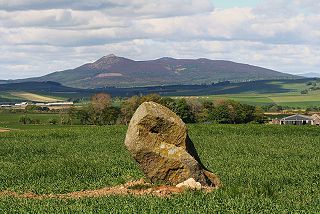
The Battle of Harlaw was a Scottish clan battle fought on 24 July 1411 just north of Inverurie in Aberdeenshire. It was one of a series of battles fought during the Middle Ages between the barons of northeast Scotland against those from the west coast.

Inverurie Loco Works Football Club are a senior semi-professional football club from Inverurie, Aberdeenshire, Scotland, who currently play in the Scottish Highland Football League (SHFL).

Aboyne is a village on the edge of the Highlands in Aberdeenshire, Scotland, on the River Dee, approximately 30 miles (48 km) west of Aberdeen. It has a swimming pool at Aboyne Academy, all-weather tennis courts, a bowling green and is home to the oldest 18 hole golf course on Royal Deeside. Aboyne Castle and the Loch of Aboyne are nearby.

Kemnay is a village 16 miles (26 km) west of Aberdeen in Garioch, Aberdeenshire, Scotland.

Garioch is one of six committee areas in Aberdeenshire, Scotland. It has a population of 46,254, which gives it the largest population of Aberdeenshire's six committee areas. The Garioch consists primarily of the district drained by the River Ury and its tributaries the Shevock and the Gadie Burn.

The Diocese of Aberdeen and Orkney is one of the seven dioceses of the Scottish Episcopal Church. Created in 1865, the diocese covers the historic county of Aberdeenshire, and the Orkney and Shetland island groups. It shares with the Roman Catholic Diocese of Aberdeen a Christian heritage that can be traced back to Norman times, and incorporates the ancient Diocese of Orkney, founded in 1035.
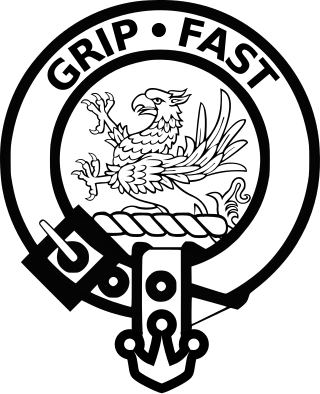
Clan Leslie is a Lowland Scottish clan. The progenitor of the Clan, Bartolf, was a nobleman from Hungary, who came to Scotland in 1067. He built a castle at Lesselyn, from which the clan name derives.

Gilbert de Greenlaw (1354–1421) was a medieval Bishop of Aberdeen and Bishop-elect of St. Andrews. He was a Licentiate in the Arts, and had been a canon of Bishopric of Moray by the late 1370s, before being provided by Avignon Pope Clement VII the church of Liston in the Bishopric of St. Andrews in 1379. By the later 1380s, he was in the diocese of Aberdeen. In 1389, he was elected to hold the bishopric of Aberdeen, a position to which he was consecrated in 1390. Gilbert subsequently went on to hold the position of Chancellor of Scotland for many years, albeit in an interrupted manner. Gilbert was subsequently postulated to the more prestigious bishopric of St. Andrews after the death of Walter de Danyelston, its previous Bishop-elect. However, Avignon Pope Benedict XIII quashed the postulation, and chose Henry Wardlaw in his stead. Gilbert, then, remained Bishop of Aberdeen, and died in 1421.
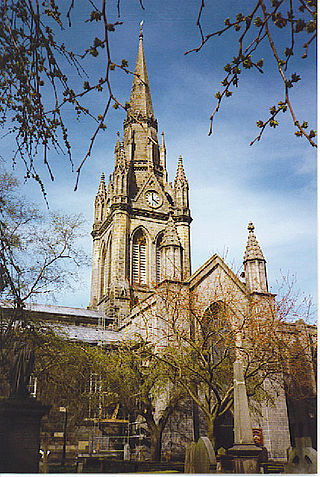
The Kirk of St Nicholas is a historic church located in the city centre of Aberdeen, Scotland. Up until the dissolution of the congregation on 31 December 2020, it was known as the "Kirk of St Nicholas Uniting". It is also known as "The Mither Kirk" of the city. As of 1 January 2021, the building falls under the care and maintenance of the General Trustees of the Church of Scotland.
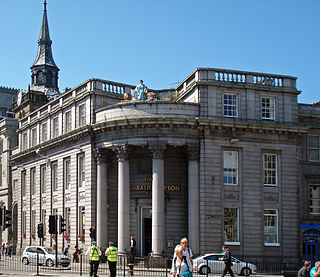
The architecture of Aberdeen, Scotland, is known for the use of granite as the principal construction material. The stone, which has been quarried in and around the city, has given Aberdeen the epithet The Granite City, or more romantically, and less commonly used, the Silver City, after the mica in the stone which sparkles in the sun.
Alexander Forbes (1564–1617) was a late 16th-century and early 17th-century senior Church of Scotland figure who was a Protestant Bishop of Aberdeen.

Henry de Lichton [de Lychtone, Leighton] was a medieval Scottish prelate and diplomat, who, serving as Bishop of Moray (1414–1422) and Bishop of Aberdeen (1422–1440), became a significant patron of the church, a cathedral builder, and a writer. He also served King James I of Scotland as a diplomat in England, France, and Italy.

St John the Evangelist — also known as St John's — off Crown Street is a Scottish Episcopal Church in Aberdeen, Scotland.
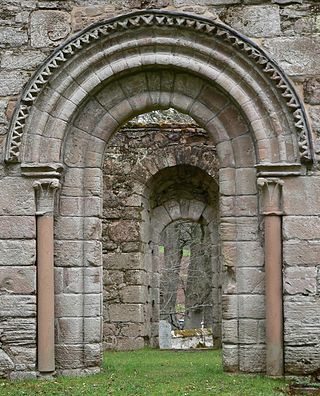
St Mary's Kirk at Auchindoir, between Rhynie and Lumsden, in Aberdeenshire, Scotland, is one of the country's finest surviving medieval parish kirks. The main doorway is early Romanesque, and there is a well-preserved early 16th-century sacrament house, similar to those at Deskford and Kinkell.
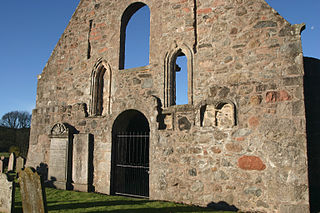
Kincardine O'Neil Hospital was founded in the 13th century in the village of Kincardine O'Neil in Scotland. Almost certainly it served as a traveler's inn and as a hospice for elderly and "poor" men. The hospital was situated adjacent to a bridge over the River Dee and may have been a chantry for the early Bishops of Mortlach. Remains of a building can be seen abutted to the Auld Parish Church in Kincardine O'Neil. This building may have been a later or second hospital. It is also possible that these ruins may have been part of St Erchard's Church - a.k.a. St Marys' or the Auld Kirk.

Canon Alexander Galloway was a 16th-century cleric from Aberdeen in Scotland. He was not only a Canon of St Machar's Cathedral, he was a Royal Notary and Diocesan Clerk for James IV and James V of Scotland; vicar of the parishes of Fordyce, Bothelny and Kinkell (1516-1552); five times Rector of King's College – University of Aberdeen; Master of Works on the Bridge of Dee in Aberdeen and for Greyfriars Church in Aberdeen; and Chancellor of the Diocese of Aberdeen. According to Steven Holmes, he was one of the most notable liturgists of his time, designing many fine examples of Sacrament Houses across the North-East of Scotland. He was a friend of and adviser to Hector Boece, the first Principal of the University of Aberdeen, as well as Bishop Elphinstone, Chancellor of Scotland and Gavin Dunbar. He was an avid anti-Reformationist being a friend of Jacobus Latomus and Erasmus and clerics in the Old University of Leuven. Along with Gavin Dunbar, Galloway designed and had built the western towers of the cathedral and designed the heraldic ceiling, featuring 48 coats of arms in three rows of sixteen. More than anyone else he contributed to the development of the artistry of Scottish lettering. He has a claim to be what some might call "a Renaissance Man".

Cullen Old Church is the parish church for Cullen and Deskford, in Moray. It was originally a part of the Roman Catholic Church, but has been a part of the Church of Scotland since the Scottish Reformation. John R. Hume describes Cullen Old Church as a fine example of late Scots Gothic architecture, and it was designated a Category A listed building in 1972. It is still an active place of worship, with weekly services presided over by Rev Douglas F Stevenson.

St. Peter's Church is a Category B listed building located on Merchant Street in Peterhead, Aberdeenshire, Scotland. It was founded in 1814 and incorporates a late-18th century house, which is believed to be the original rectory. Today's structure was built on the site of a 1798 church; it opened for worship on 24 December 1814; it was consecrated on 2 August 1857 by Bishop Suther. The church's architect was Robert Mitchell.
{{cite book}}: CS1 maint: location missing publisher (link)